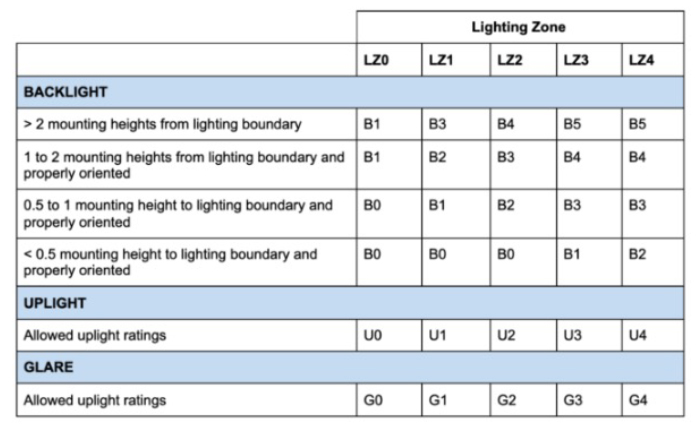Blog
IES TM-15-11: BUG (Backlight, Uplight, and Glare) Ratings explained
What do we need to know?
BUG Rating, also known as Backlight-Uplight-Glare Rating, is a system that evaluates and specifies the optical performance of outdoor light fixtures. Specifically, BUG assesses the impact of a luminaire’s backlight, uplight, and glare characteristics on its overall performance and efficiency. Published in the technical memorandum “Luminaires Classification for Outdoor Luminaires” (TM-15-11) by the Illuminating Engineering Society (IES), it is reinforced by DarkSky International.
BUG Ratings focus on three main components:
Backlight (B): This rating is related to the amount of light emanating toward the back of the luminaire.
Uplight (U): This rating is related to the amount of light that emanates upward from the luminaire, which may contribute to light pollution.
Glare (G): This rating considers the amount of visual discomfort for observers, in different positions, caused by glare from the luminaire.

In simple terms, a BUG Rating quantifies where the light goes. In most cases, we want lower numbers, which indicate that the light is going where it’s supposed to rather than to unintended areas. The IES and International Dark Sky Association’s model lighting ordinance clearly defines what those recommended rating levels should be.
Why are BUG Ratings so important in outdoor lighting applications for the lighting industry? Some states have included BUG Ratings as part of their Energy Code—for example in California (CA Title 24 2022 – Outdoor Lighting). This 2022 Energy Code includes outdoor luminaire shielding requirements based on the luminaire’s initial lumen rating. All outdoor luminaires that emit 6,200 initial lumens or greater must comply with backlight, uplight, and glare (BUG) requirements contained in §5.106.8 of the CALGreen Code (Title 24, Part 11).
The outdoor lighting section of the Energy Standards sets minimum control requirements, maximum allowable power levels, minimum efficacy requirements, and cutoff (uplight and glare) zonal lumen limits for outdoor luminaires. The basic premise of these Energy Standards is to base allowable outdoor lighting power on the brightness of the surrounding area. The Energy Standards contain lighting power allowances for new lighting installations, as well as specific alterations that are dependent on the lighting zone of the project location.
Five categories of outdoor lighting zones are defined: LZ0, LZ1, LZ2, LZ3, and LZ4. Lighting zones with lower numbers are darker than LZ0, which includes national parks and other areas intended to be very dark at night The LZ4 zones are designated for high intensity nighttime use, such as entertainment or commercial districts and other areas with special security considerations requiring very high light levels.The following summarizes the default locations for outdoor lighting zones as specified in §10-114:
• Lighting Zone 0 areas: undeveloped areas of government designated parks, recreation areas, and wildlife preserves.
• Lighting Zone 1 areas: developed portions of government designated parks, recreation areas and wildlife preserves.
• Lighting Zone 2: rural areas
• Lighting Zone 3: urban areas
• Lighting Zone 4: special use districts that may be created by a local government through application to the Energy Commission.
Example of the Lighting Zones and allowable level:


